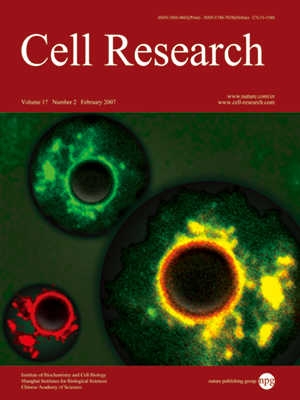
Volume 17, No 2, Feb 2007
ISSN: 1001-0602
EISSN: 1748-7838 2018
impact factor 17.848*
(Clarivate Analytics, 2019)
Volume 17 Issue 2, February 2007: 117-134
ORIGINAL ARTICLES
Nuclear reprogramming: the zygotic transcription program is established through an
Feng Sun1,*, Haiyan Fang2,*, Ruizhen Li2,*, Tianlong Gao1, Junke Zheng2, Xuejin Chen2, Wenqin Ying2, Hui Z Sheng2
1Program for Graduation Studies, Shanghai Institutes for Biological Sciences, Chinese Academy of Sciences, Shanghai 200031,
China; 2Center for Developmental Biology, Xinhua Hospital, School of Medicine, Shanghai Jiao Tong University, 1665 Kong Jiang
Road, Shanghai 200092, China
Correspondence: Zhengjun Chen(zjchen@sibs.ac.cn)
Oocytes display a maternal-specific gene expression profile, which is switched to a zygotic profile when a haploid set of chromatin is passed on to the fertilized egg that develops into an embryo. The mechanism underlying this transcription reprogramming is currently unknown. Here we demonstrate that by the time when transcription is shut down in germinal vesicle oocytes, a range of general transcription factors and transcriptional regulators are dissociated from the chromatin. The global dissociation of chromatin factors (CFs) disrupts physical contacts between the chromatin and CFs and leads to erasure of the maternal transcription program at the functional level. Critical transcription factors and regulators remain separated from chromatin for a prolonged period, and become re-associated with chromatin shortly after pronuclear formation. This is followed temporally by the re-establishment of nuclear functions such as DNA replication and transcription. We propose that the maternal transcription program is erased during oogenesis to generate a relatively na飗e chromatin and the zygotic transcription program is rebuilt de novo after fertilization. This process is termed as the "erase-and-rebuild" process, which is used to reset the transcription program, and most likely other nuclear processes as well, from a maternal one to that of the embryo. We further show in the accompanying paper (Gao T, et al., Cell Res 2007) that the same strategy is also employed to reprogram transcriptional profiles in somatic cell nuclear transfer and parthenogenesis, suggesting that this model is universally applicable to all forms of transcriptional reprogramming during early embryogenesis. Displacement of CFs from chromatin also offers an explanation for the phenomenon of transcription silence during the maternal to zygotic transition.
Cell Research (2007) 17:117-134. doi: 10.1038/cr.2007.1; published online 6 February 2007
FULL TEXT | PDF
Browse 2171


